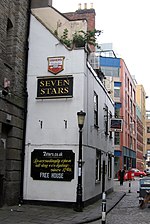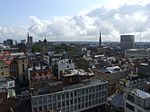Wool Hall, Bristol
1830 establishments in EnglandByzantine Revival architecture in the United KingdomCommercial buildings completed in 1830Grade II listed buildings in BristolGrade II listed commercial buildings ... and 4 more
Grade II listed industrial buildingsIndustrial buildings completed in 1830Music venues in BristolUse British English from February 2023

The Wool Hall is a historic building in St Thomas Street, Redcliffe, Bristol.
Excerpt from the Wikipedia article Wool Hall, Bristol (License: CC BY-SA 3.0, Authors, Images).Wool Hall, Bristol
Saint Thomas Street, Bristol Redcliffe
Geographical coordinates (GPS) Address External links Nearby Places Show on map
Geographical coordinates (GPS)
| Latitude | Longitude |
|---|---|
| N 51.4522 ° | E -2.5894 ° |
Address
The Fleece
Saint Thomas Street 12
BS1 6JJ Bristol, Redcliffe
England, United Kingdom
Open on Google Maps










